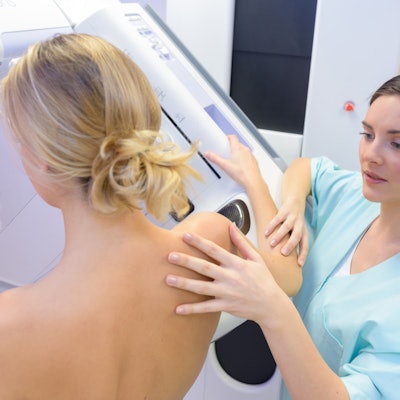
The daily routines of breast imaging staff members have been upended amid the ongoing COVID-19 outbreak. Six radiologists from across the U.S. detailed how they're triaging patients and managing workflows in an article published on April 1 in the Journal of Breast Imaging.
The authors include radiology professors and breast imaging chairs from New York, Georgia, Ohio, and Texas. While most of the radiologists expressed uncertainty over delayed screenings and diagnostic exams, some were optimistic that valuable lessons will come from the novel coronavirus pandemic.
"I'm hopeful this crisis will build collaboration between our subspecialty divisions and our community and regional sites," wrote Dr. Jennifer Harvey from the University of Rochester Medical Center in Rochester, NY. "We can all be stronger for going through this together."
Below are four things the radiologists say have changed at their institutions during the COVID-19 pandemic.
1. No routine screenings
All six authors reported stopping routine mammography and ultrasound screenings during the outbreak. Some radiologists have rescheduled screening exams for dates after state-issued stay-at-home orders are currently set to expire, while others are waiting to reschedule appointments until an end date is more definite.
Many radiologists are prioritizing which patients to see first when screenings eventually resume. Some also plan to hold extended or weekend hours to address the growing backlog of patients.
2. New meaning of urgent appointments
Even during a pandemic, some patients have time-sensitive imaging needs. But who counts as urgent largely depends on the institution.
Staff at Emory University Health System in Atlanta are seeing patients with confirmed or likely breast cancer cases. While those at the University of Rochester Medical Center and the University of Texas MD Anderson Cancer Center in Houston have rescheduled patients with BI-RADS 3 and BI-RADS 4A imaging findings.
New York University (NYU) Langone Health is continuing to perform percutaneous ultrasound, tomosynthesis, MRI-guided biopsies, and nonwire localizations for some patients, but the center halted breast cancer surgeries. Patients with breast cancer are instead referred to oral therapy or other treatments until surgeries resume.
Deciding which patients to see isn't always dependent on a list of predefined criteria. Rather, some radiologists are having to trust their expertise for which patients to see.
"Unfortunately, as we are finding, this is difficult and necessarily subjective," wrote Dr. Mary Newell from Emory University Health System. "The one thing I know: We breast imaging radiologists will approach this task with diligence and vigilance, in a way that serves the most in the best manner possible."
3. Stricter infection control
All breast imaging departments have added additional protections for radiologists and other staff members.
Many staff members wear masks, and some patients bring their own masks, too. In addition, facilities have added social distancing measures, such as limiting the number of chairs in waiting rooms and scheduling appointments 30 minutes apart or only on certain days.
Patients are also screened for COVID-19 through questionnaires and/or temperature checks before seeing imaging staff. At NYU, patients are screened twice -- first by a nurse in the lobby and again at the breast imaging front desk.
Precautions to keep staff at least six feet apart from each other have also gone into place. This includes radiologists consulting with technologists through phone calls at MD Anderson Cancer Center, working from home at the University of Rochester Cancer Center, and prioritizing telehealth appointments at the Case Western Reserve University School of Medicine.
4. Changes to work time
With fewer patients to see, radiologists, staff, and residents have changed their work routines.
Many radiologists at the academic institutions are using work time to make progress on research topics, while others are using the time to participate in webinars or learn about trending topics, such as artificial intelligence.
Some breast imaging staff members also have volunteered to be deployed to other areas if they have the necessary skills and experience. This includes reading chest images and CT scans.
"Technologists and other staff from breast and other imaging areas with lower volumes are being reassigned to areas of anticipated greater need such as CT, where that skill set is viable," Harvey wrote. "As we have a large network, we are working to cross-train at other sites as well."



















